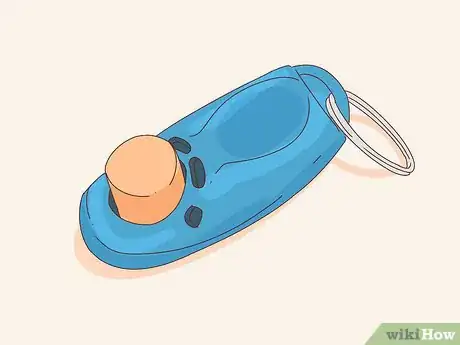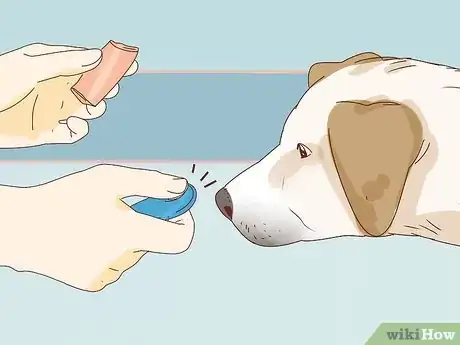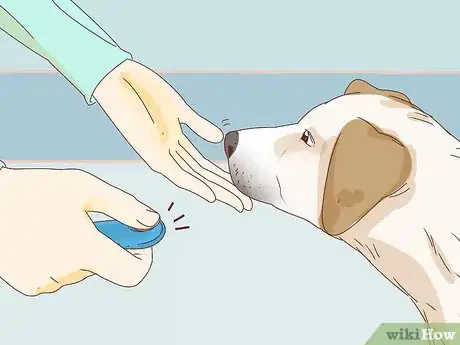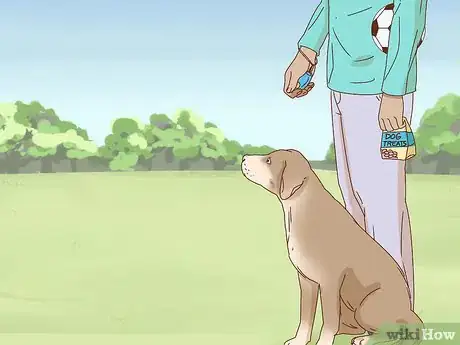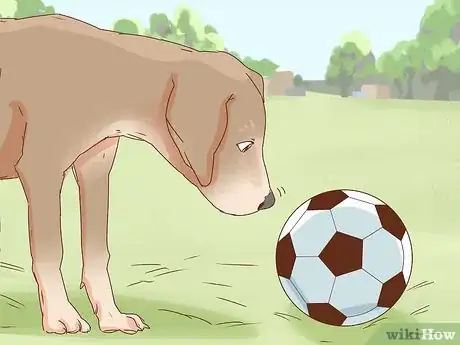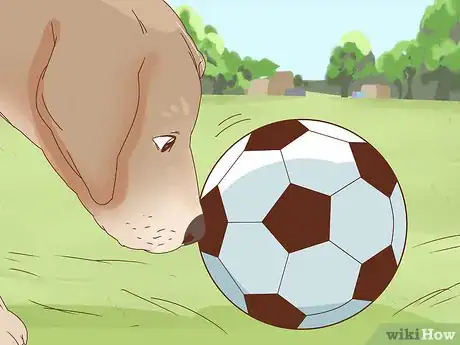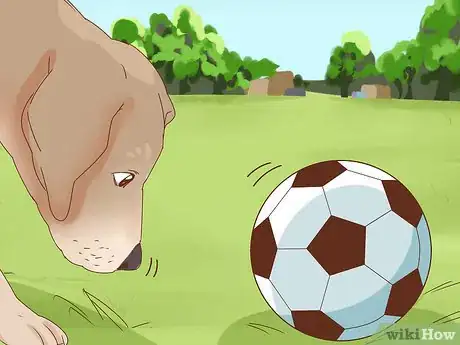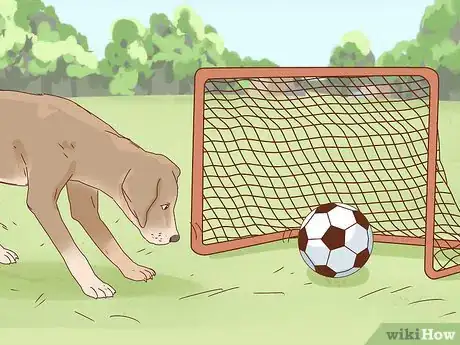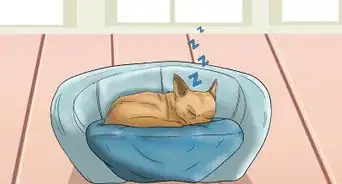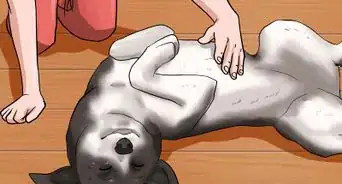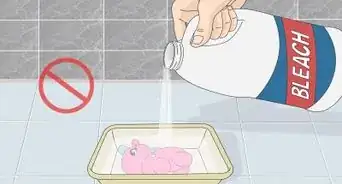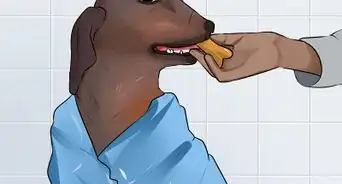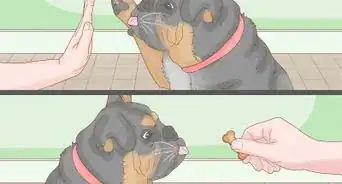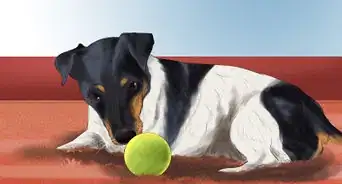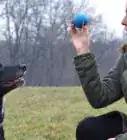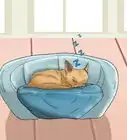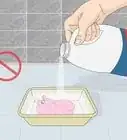This article was co-authored by Jennifer Damon and by wikiHow staff writer, Sophia Latorre. Jennifer Damon is a Professional Dog Trainer and the Owner of Love for Paws Dog Training in Richmond, VA. With over 10 years of experience training dogs, Jennifer specializes in determining the psychology that motivates dog behavior. As a supporting member of the International Association of Animal Behavior Consultants, Jennifer is passionate about improving the communication between owners and their pets through gentle, scientifically-backed methods. She holds a BFA in Communication Arts from the University of Montevallo and a Certificate in Canine Behavior Consulting from The International College of Canine Studies.
There are 8 references cited in this article, which can be found at the bottom of the page.
This article has been viewed 41,574 times.
Dogs are loveable pets with significant learning capabilities. If you want to teach your dog some new skills, training it to play soccer is a great option. The best way to teach your dog to play soccer is by clicker-training it to identify a target, then teaching it to dribble a soccer ball and score a goal.
Steps
Training Your Dog to Respond to a Clicker
-
1Purchase a clicker at a pet supply store. A clicker is a hand-held dog training device that, when pushed, makes a "click" sound. When your dog performs the desired behavior, you press the device. Then, you reward the dog with a treat. Your pet will learn to associate that behavior with rewards.[1]
- Pressing the clicker when the dog performs a behavior is much more effective than saying "Good dog." This is because a clicker has a distinctive and unchanging sound and the dog hears the sound at the exact moment a behavior occurs.
-
2Teach your dog to associate the sound of the click with a reward. Prepare several small pieces of a highly desirable treat, such as bits of hotdog or boiled chicken. Then, press the clicker and reward your dog with a treat. Do the clicker-treat action repeatedly. Teaching your dog to pay attention to the clicker is called "charging the clicker."[2]
- You can switch rewards later on in the training session to something more mundane like kibble, but using special treats keeps your dog's enthusiasm for the clicker high.
Advertisement -
3Train your dog to identify a target. Before training your dog to play soccer, teach it how to identify a target. Place 1 of your hands in front of your dog’s face with your palm flat and facing the dog. When your dog sniffs your hand, click the clicker and give your dog a treat with your other hand. Repeat this at least 3 times to reinforce the behavior.[3]
- Then, begin moving your hand to either side and up and down to train your dog to find the target in a different location. Click and reward your dog each time it sniffs your hand.
- Clicker training relies on exact timing. Click the moment your dog performs the desired behavior.
- When you teach your dog to play soccer, the ball will be the target.
Teaching Your Dog to Play Soccer
-
1Take your dog to a distraction-free area. Dogs get distracted easily, so choose a quiet place like a basement, fenced backyard, or local athletic field after practice. Avoid playing in busy places, like at a park full of kids or other dogs.[4]
- All you need is a soccer ball, a soccer goal, small treats, and the clicker.
-
2Reward your dog for showing interest in the soccer ball. Use a dog-proof soccer ball or an old one that you won’t mind if it gets ruined. Start by rewarding your dog for looking at the ball.[5] If your dog refuses to look at the soccer ball or is more interested in getting treats, roll the ball to get your dog to focus on it. When your dog targets the ball, click and give it a treat.[6]
- It's very important to keep the ball under your control at all times. To that end, avoid letting your dog play freely with the ball during training.
-
3Up the ante by rewarding your dog for touching the ball. Now that your dog is aware of the ball, encourage it to touch the ball with its nose or paw in order to earn a click and a treat.[7] Your dog might be more likely to touch the ball with when it's moving, so feel free to roll it around a bit.[8]
-
4Click and reward your dog for moving the ball with its nose or paws. Once your dog is used to touching the ball, you can stop giving it rewards for that part of the task. Instead, immediately click and reward when your dog pushes the ball with its nose or paws, even if it only moves slightly at first.[9] Keep practicing until your dog continues to push the ball 10–15 feet (3.0–4.6 m) at a time.[10]
- Be precise during this part of the training. Remember, the goal is to get your dog to dribble the ball down the soccer pitch.
-
5Encourage your dog to push the ball into the goal. Position the soccer ball a few paces in front of the goal. Let your dog move the ball with its nose or paws into the goal, then click and reward your pup for learning a new trick. Repeat the process until your dog consistently pushes the ball into the goal.[11]
- Move the ball further away from the goal as your dog gets the hang of the trick and wait to click until the ball enters the goal, not when your dog pushes it, to reinforce the behavior.
Expert Q&A
-
QuestionDo dogs like to play soccer?
 Jennifer DamonJennifer Damon is a Professional Dog Trainer and the Owner of Love for Paws Dog Training in Richmond, VA. With over 10 years of experience training dogs, Jennifer specializes in determining the psychology that motivates dog behavior. As a supporting member of the International Association of Animal Behavior Consultants, Jennifer is passionate about improving the communication between owners and their pets through gentle, scientifically-backed methods. She holds a BFA in Communication Arts from the University of Montevallo and a Certificate in Canine Behavior Consulting from The International College of Canine Studies.
Jennifer DamonJennifer Damon is a Professional Dog Trainer and the Owner of Love for Paws Dog Training in Richmond, VA. With over 10 years of experience training dogs, Jennifer specializes in determining the psychology that motivates dog behavior. As a supporting member of the International Association of Animal Behavior Consultants, Jennifer is passionate about improving the communication between owners and their pets through gentle, scientifically-backed methods. She holds a BFA in Communication Arts from the University of Montevallo and a Certificate in Canine Behavior Consulting from The International College of Canine Studies.
Professional Dog Trainer They can like it, but you will most likely need to teach him how to play with training and rewards.
They can like it, but you will most likely need to teach him how to play with training and rewards. -
QuestionDo I have to use a clicker?
 Jennifer DamonJennifer Damon is a Professional Dog Trainer and the Owner of Love for Paws Dog Training in Richmond, VA. With over 10 years of experience training dogs, Jennifer specializes in determining the psychology that motivates dog behavior. As a supporting member of the International Association of Animal Behavior Consultants, Jennifer is passionate about improving the communication between owners and their pets through gentle, scientifically-backed methods. She holds a BFA in Communication Arts from the University of Montevallo and a Certificate in Canine Behavior Consulting from The International College of Canine Studies.
Jennifer DamonJennifer Damon is a Professional Dog Trainer and the Owner of Love for Paws Dog Training in Richmond, VA. With over 10 years of experience training dogs, Jennifer specializes in determining the psychology that motivates dog behavior. As a supporting member of the International Association of Animal Behavior Consultants, Jennifer is passionate about improving the communication between owners and their pets through gentle, scientifically-backed methods. She holds a BFA in Communication Arts from the University of Montevallo and a Certificate in Canine Behavior Consulting from The International College of Canine Studies.
Professional Dog Trainer The clicker is just a tool that you use to mark a correct behavior easily. You can also mark the behavior using your voice, as long as you keep it consistent and don’t add any additional words.
The clicker is just a tool that you use to mark a correct behavior easily. You can also mark the behavior using your voice, as long as you keep it consistent and don’t add any additional words. -
QuestionDo I need to work with a trainer?
 Jennifer DamonJennifer Damon is a Professional Dog Trainer and the Owner of Love for Paws Dog Training in Richmond, VA. With over 10 years of experience training dogs, Jennifer specializes in determining the psychology that motivates dog behavior. As a supporting member of the International Association of Animal Behavior Consultants, Jennifer is passionate about improving the communication between owners and their pets through gentle, scientifically-backed methods. She holds a BFA in Communication Arts from the University of Montevallo and a Certificate in Canine Behavior Consulting from The International College of Canine Studies.
Jennifer DamonJennifer Damon is a Professional Dog Trainer and the Owner of Love for Paws Dog Training in Richmond, VA. With over 10 years of experience training dogs, Jennifer specializes in determining the psychology that motivates dog behavior. As a supporting member of the International Association of Animal Behavior Consultants, Jennifer is passionate about improving the communication between owners and their pets through gentle, scientifically-backed methods. She holds a BFA in Communication Arts from the University of Montevallo and a Certificate in Canine Behavior Consulting from The International College of Canine Studies.
Professional Dog Trainer You can absolutely work with a trainer, but with tricks like this, it pays to just give it some time. Make sure the treat you're offering is something your dog loves and put in some effort for a few minutes a day.
You can absolutely work with a trainer, but with tricks like this, it pays to just give it some time. Make sure the treat you're offering is something your dog loves and put in some effort for a few minutes a day.
Warnings
- Discourage your dog from biting the ball or playing freely with it during training sessions.⧼thumbs_response⧽
Things You'll Need
- A clicker
- Dog treats
- A soccer ball
- A soccer goal
References
- ↑ https://www.akc.org/expert-advice/training/what-is-clicker-training-a-great-way-to-shape-your-dogs-behavior/
- ↑ https://www.ddfl.org/resources/getting-started-with-the-clicker
- ↑ https://www.ddfl.org/resources/getting-started-with-the-clicker
- ↑ https://www.akc.org/expert-advice/training/soccer-ball-roll/
- ↑ Jennifer Damon. Professional Dog Trainer. Expert Interview. 18 August 2021.
- ↑ https://youtu.be/wcpsAWIyLRM?t=77
- ↑ Jennifer Damon. Professional Dog Trainer. Expert Interview. 18 August 2021.
- ↑ https://youtu.be/wcpsAWIyLRM?t=96
- ↑ Jennifer Damon. Professional Dog Trainer. Expert Interview. 18 August 2021.
